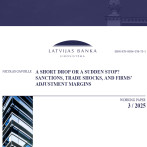How did Latvian firms exposed to Russia adapt to trade sanctions?

The Russian full-scale invasion of Ukraine in February 2022 triggered a swift and far-reaching set of sanctions from the European Union. For Latvian firms doing business with Russia before 2022, this translated into a sudden and large external shock. How did these firms adapt? This policy brief summarizes recent empirical findings on how Latvian firms adjusted to this shock, relying on detailed administrative data covering trade, employment, and financial performance.[1]
Before the full-scale invasion, Russia still ranked among Latvia’s top five trading partners, both for exports and imports. Nearly one in five Latvian exporters and one in six importers had commercial ties with Russian partners in 2021. As a result, the sanctions adopted by the European Union – including bans on a broadening list of traded goods, restrictions on transactions with designated individuals and entities, and limitations on payment systems – directly impacted many Latvian firms.
However, not all firms that traded with Russia before the full-scale invasion were hit by the trade shock: many firms doing business with Russia in 2021 would have ended this trade relationship in 2022, had the war not started. Every year, a significant number of trade relationships dissolve in the normal course of business. In any given year between 2010 and 2020, about 30-40% of Latvian firms trading with Russia exited that market in the following year, as shown in Figure 1.
Studying firms’ reaction to a trade shock requires determining which firms actually experienced trade disruption. For this purpose, the study uses a machine learning algorithm aiming at predicting whether a firm that traded with Russia in 2021 would have continued to do so in 2022, had the full-scale invasion not started. This prediction essentially draws on firms’ past trade behavior and firms’ characteristics, and enables restricting the analysis to firms likely to have been affected by the shock.
Among these impacted firms, some were mildly affected, some others received a big hit. But how to measure it? For this purpose, the study measures the magnitude of the shock intensity based on two distinct components: exposure and bite. Exposure captures the share of a firm’s turnover in 2021 that came from trade with Russia, thus reflecting the potential scale of disruption. Bite measures the extent to which that trade involved goods that were subsequently banned under EU sanctions. While the former reflects broad cost and compliance burdens, the latter represents direct legal restrictions on specific trade flows. Figures 2 and 3 show that both measures greatly vary across firms: some firms only marginally trade with Russia, whereas some others generate all their turnover in Russia. At the same time, some firms see all the goods they trade falling on the sanctions list, whereas some others are totally spared. However, a firm exporting to Russia only goods subsequently falling under sanctions, but for which Russia is a minor trade partner, is likely to receive a smaller hit than a firm that was not exporting goods on the sanctions lists but which generates a large part of its revenue in Russia. Considering the exposure and the bite together is a way to acknowledge this difference.
The empirical analysis reveals that more than half of the Latvian firms that traded with Russia in 2021 (and were predicted to maintain this trade in 2022) ceased doing so in 2022 – a substantial increase relative to previous years. Figure 4 shows the estimated probability of exiting depending on the initial exposure to Russia, for a firm not affected by sanction bans (dashed line) and for an average affected firm (solid line). The initial exposure level matters (a lot): firms with minimal exposure were highly likely to abandon the Russian market, while highly exposed firms were more likely to persist. Interestingly, the goods-specific sanctions – while important in principle – do not appear to have directly influenced firms’ exit decisions. Instead, the presence of sanctions may have raised transaction costs and legal risks more broadly, encouraging precautionary disengagement even among firms not directly targeted. Even among firms remaining in the Russian market, the volume exported was on average drastically reduced.
How did firms cope with this trade shock? While many firms exited without major disruptions, the economic costs of the trade shock were concentrated among a small set of highly exposed firms. First, among exporters generating more than 25 percent of their turnover from Russia, the likelihood of firm closure increased markedly, and surviving firms in this group experienced an average decline in employment of around ten percent. Monthly labor data show that these employment effects materialized rapidly, with significant reductions evident by mid-2022. These findings indicate that while sanctions did not trigger widespread firm distress, they had sharp and immediate consequences for the most exposed firms.
Second, the analysis also considers firms’ ability to adapt their trade strategies in response to the shock. Among exporters with limited exposure to Russia, many discontinued trade with Russia but expanded their presence in other foreign markets, suggesting a degree of resilience and flexibility. For more heavily exposed firms, especially those affected by product-specific bans, there is evidence of redirection toward CIS countries. The probability of starting exports to CIS destinations increased substantially with initial exposure to Russia, and nearly half of the new trade relationships involved goods under EU sanctions, suggesting potential sanction evasion or circumvention. In contrast, importers were less likely to reorient trade and more prone to contract their overall import activity, indicating that substitution of inputs may be more difficult than finding new export markets.
Third, the trade shock also impacted financial outcomes of the most exposed firms, which saw a significant reduction in turnover and profitability. Exporters with low exposure generally maintained (or even increased) turnover levels, but still experienced a (slight) decline in profitability. These results suggest that even when firms succeed in adjusting their trade flows, doing so may come with higher costs that erode profit margins.
Taken together, these results indicate that the economic impact of sanctions on Latvian firms is essentially borne by firms that had deep commercial ties to Russia before the war, while others adjust with relative ease. This analysis suggests that the set of firms trading with the country under sanctions can dramatically change, altering the nature of the trade relationship beyond the mere level of aggregate trade flows. As sanctions become a more prominent tool in trade and foreign policy, careful consideration of the adjustment mechanisms at the firm-level will be critical for designing optimal policy responses.
[1] Working Paper: https://www.macroeconomics.lv/working-papers/short-drop-or-sudden-stop-sanctions-trade-shocks-and-firms-adjustment-margins
Textual error
«… …»






